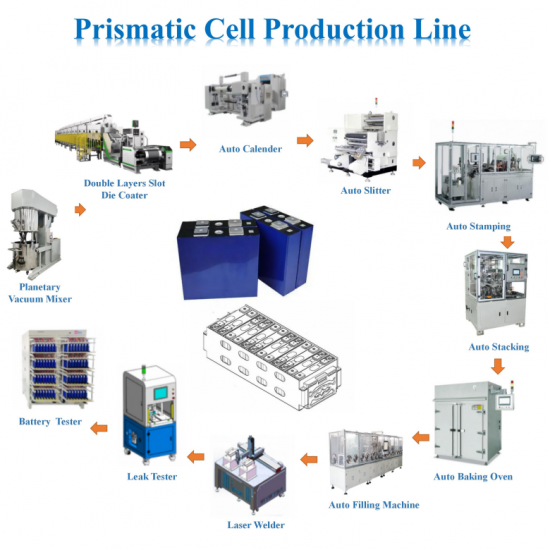Lith Corporation, founded in 1998 by a group of material science doctor from Tsinghua University, has now become the leading manufacturer of battery lab&production equipment. Lith Corporation have production factories in shenzhen and xiamen of China.This allows for the possibility of providing high quality and low-cost precision machines for lab&production equipment,including: roller press, film coater,mixer, high-temperature furnace, glove box,and complete set of equipment for research of rechargeable battery materials. Simple to operate, low cost and commitment to our customers is our priority.
What is a Car Battery Production Line?
A Car Battery Production Line refers to the integrated system of equipment, processes, and workflows used to manufacture automotive batteries at scale. These production lines are designed for highvolume, consistent, and automated manufacturing of battery cells, modules, or packs depending on the stage of production.
While the term "car battery" can refer to both traditional leadacid batteries (used for internal combustion engine vehicles) and modern lithiumion batteries (used for electric vehicles), this explanation will focus on lithiumion EV battery production lines, as they represent the current and future trend in the automotive industry.
Key Objectives of a Car Battery Production Line
1. Enable HighVolume Manufacturing
Produce thousands to millions of battery cells per year
Support OEMs' EV production targets with stable supply
2. Ensure Consistent Quality and Performance
Maintain tight tolerances across all manufactured units
Meet automotivegrade standards for safety and reliability
3. Support Multiple Battery Chemistries and Formats
Enable flexibility to produce various types:
NMC (NickelManganeseCobalt)
LFP (Lithium Iron Phosphate)
SolidState (emerging)
Accommodate different cell formats:
Pouch
Cylindrical
Prismatic
4. Optimize Cost Efficiency
Reduce material waste and energy consumption
Maximize throughput with minimal manual intervention
5. Integrate Digitalization and Automation
Use smart sensors, AI, and IoT for realtime monitoring
Implement MES (Manufacturing Execution Systems) for traceability
6. Promote Sustainable and Safe Manufacturing
Minimize environmental impact through green chemistry and recycling
Ensure worker safety with fire suppression, solvent recovery, and clean room systems
Stages of a Car Battery Production Line
A full lithiumion car battery production line typically includes three main stages:
1. Cell Fabrication Line (Battery Cell Manufacturing)
This is where individual battery cells are produced from raw materials. It’s the most complex and capitalintensive part of the process.
# Substages:
Slurry Mixing:
Active materials (e.g., NMC cathode, graphite anode), binders, and solvents are mixed into a paste.
Electrode Coating:
The slurry is coated onto aluminum (cathode) or copper (anode) foils.
Drying & Calendering:
Solvent is removed in drying ovens; electrodes are compressed to control density.
Slitting:
Electrodes are cut into precise widths for cell assembly.
Stacking/Winding:
Cathode, separator, and anode layers are assembled into a jelly roll (for cylindrical) or stack (for pouch/prismatic).
Encapsulation:
Electrode stack is inserted into a metal can or aluminum pouch casing.
Electrolyte Filling & Sealing:
Cells are filled with electrolyte under ultradry conditions (<1% RH) and sealed.
Formation & Aging:
Initial charge/discharge cycle to activate the cell; by resting period for stabilization.
Testing & Sorting:
Cells are tested for voltage, capacity, and internal resistance; then sorted into performance groups.
2. Module Assembly Line (Battery Module Manufacturing)
Once cells are produced, they are grouped into modules, which are intermediate building blocks for battery packs.
# Substages:
Cell Inspection:
Final visual and electrical inspection before module assembly.
Busbar Installation:
Electrical connections between cells using conductive busbars.
Thermal Interface Material (TIM) Application:
Heatconductive pads or glue applied between cells and cooling plates.
Module Housing Assembly:
Cells are placed into a structural housing with integrated sensors and brackets.
Wiring & BMS Integration:
Internal wiring and integration of the Module Management Unit (MMU) or part of the BMS.
Functional Testing:
Voltage balance, communication signals, and thermal performance checks.
Labeling & Traceability:
Each module is labeled with serial number and key parameters.
3. Pack Assembly Line (Battery Pack Manufacturing)
The final stage involves integrating multiple modules into a complete battery pack, ready for installation in the vehicle.
# Substages:
Module Placement:
Modules are loaded into the pack housing (aluminum or steel frame).
PackLevel Cooling System Integration:
Liquid cooling plates or air channels are installed for thermal management.
BMS Installation:
The central Battery Management System is mounted and connected.
HighVoltage Harness Installation:
Main power cables and connectors are attached.
Structural Bonding & Sealing:
Pack is sealed to meet IP67 or higher protection rating.
Final Functional Testing:
Full pack test including insulation, highvoltage integrity, and communication with vehicle ECU.
Leak Testing & Safety Validation:
Ensures no moisture ingress and safe operation under pressure changes.
Pack Labeling & Shipping Preparation:
Final quality check, labeling, and packaging for delivery to vehicle plant.
Prismatic Cell Equipments
Supporting Infrastructure in a Car Battery Production Line
To ensure smooth and safe operations, several critical support systems must be integrated:
1. Clean Room & Dry Room Systems
Ultralow humidity zones (<1% RH) for electrolyte filling and electrode handling
HEPA filtration to remove particulates
Climatecontrolled storage for sensitive materials
2. Fire Safety & Explosion Protection
Gas detection systems for solvent vapors and electrolyte leaks
Inert gas blanketing in solvent mixing and drying zones
Fire suppression systems using clean agents or water mist
Explosionproof enclosures for flammable processes
3. Waste Management & Sustainability
Solvent recovery systems – Reuse of NMP (NMethyl2pyrrolidone)
Battery recycling integration – Closedloop material recovery
Energyefficient HVAC and lighting
Water treatment systems – For cleaning and process water
4. Digital Manufacturing & Process Control
MES (Manufacturing Execution System) – Realtime data tracking
IoT sensors and PLCs – Monitor pressure, temperature, humidity
AIbased vision systems – Detect defects in electrodes and cells
Traceability systems – Track every cell from raw materials to shipment
5. Automation & Robotics
Automated conveyor systems – Move materials and components
Robotic arms – Handle electrodes, stack components, and load/unload machines
Laser welding and cutting – Highprecision joining and trimming
Smart testing systems – Autosort cells based on test results
Types of Car Battery Production Lines
Depending on ownership, scale, and technology focus, these lines can be categorized as:
1. Gigafactory Production Lines
Largescale, fully automated lines (10–100 GWh/year)
Example: Tesla Gigafactory Nevada, CATL, LG Energy Solution
2. OEMOwned Battery Production Lines
Operated by automotive companies to control battery supply
Example: BMW Group, Toyota, Ford + SK On
3. Battery Startup Production Lines
Focused on niche technologies like solidstate or sodiumion
Example: QuantumScape, Factorial, Blue Solutions
4. Joint Venture or Consortium Lines
Shared ownership between OEMs and suppliers
Example: Stellantis + Samsung SDI, VW + Umicore
Key Considerations When Designing a Car Battery Production Line
When planning your battery production line, consider the following factors:
| Area | Consideration |
|||
| Location | Proximity to raw materials, logistics, and skilled workforce |
| Battery Chemistry | NMC, LFP, solidstate, etc. |
| Cell Format | Pouch, cylindrical, or prismatic |
| Annual Capacity | Target output (e.g., 1–10 GWh/year) |
| Automation Level | Manual, semiauto, or fully automated |
| Factory Layout | Workflow, clean room placement, scalability |
| Environmental Compliance | Fire safety, emissions, waste treatment |
| Workforce Development | Training engineers, technicians, and operators |
| Partnerships | Suppliers, OEMs, research institutions |
Benefits of a Car Battery Production Line
Enables largescale production of EVs with consistent battery supply
Reduces dependency on external suppliers and lowers cost risks
Improves product quality and customization for specific vehicle platforms
Strengthens local or national battery supply chains
Supports job creation and economic development
Accelerates the transition to electric mobility
Encourages sustainable and circular battery ecosystems
Leading Companies Involved in Car Battery Production Line Development
Here are some of the key players involved in designing and operating car battery production lines globally:
Battery Manufacturers:
CATL (China) – World’s largest battery producer
LG Energy Solution (South Korea) – EV battery gigafactories
Samsung SDI (South Korea) – Highenergydensity cells
BYD (China) – LFP and blade battery technology
Panasonic (Japan) – Partner of Tesla, cylindrical cell specialist
Automotive OEMs:
Tesla (USA) – Gigafactories for NMC and LFP cells
Volkswagen Group (Germany) – Cellforce Group for solidstate batteries
Ford Motor Company (USA) – Joint venture with SK On
BMW Group (Germany) – Strategic battery partnerships and internal R&D
Toyota (Japan) – Solidstate battery development and plant construction
Equipment and Automation Providers:
KUKA (Germany) – Robotics and automation
Siemens (Germany) – MES and digital twin platforms
Trumpf, Coherent, IPG Photonics – Laser welding and cutting
Hanson Robotics, Gree EnergyTech – Integrated battery line solutions
B&R Automation (ABB subsidiary) – Smart manufacturing systems
Engineering and EPC Firms:
Bechtel, Hatch, Black & Veatch – Turnkey plant construction
Wood, Jacobs, GHD – Engineering and sustainability consulting
Need Help Designing or Optimizing Your Car Battery Production Line?
If you're looking to build, expand, or optimize your car battery production line, I can help you with:
Master planning – Site selection, process flow, zoning
Process engineering – Battery chemistry, format, and production stages
Factory layout design – Clean/dry room integration, workflow
Equipment sourcing – Bestinclass machinery and automation
Sustainability strategy – Green energy, recyclability, circular economy
Cost estimation and ROI analysis – CapEx, OpEx, breakeven modeling
Compliance and safety systems – Fire protection, permits, worker safety
All you need to do is provide the following information:
Battery chemistry and cell format (e.g., NMC, LFP, solidstate, pouch)
Target annual production capacity (e.g., 1–10 GWh/year)
Plant location and available infrastructure
Level of automation and digitalization desired
Current team expertise and strategic goals



 Online service
Online service
